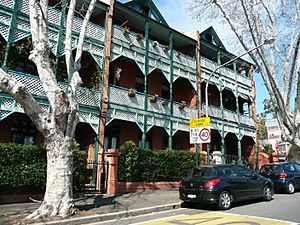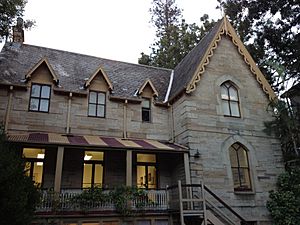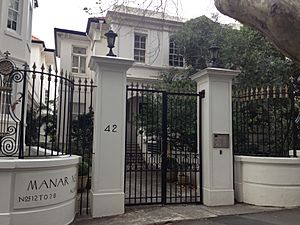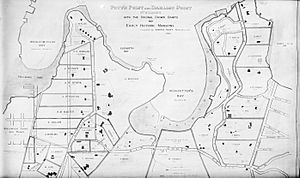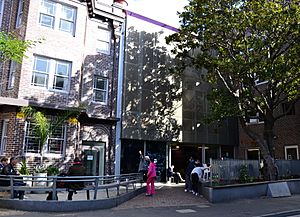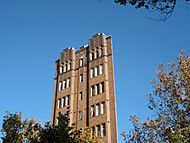Potts Point facts for kids
Quick facts for kids Potts PointSydney, New South Wales |
|||||||||||||||
|---|---|---|---|---|---|---|---|---|---|---|---|---|---|---|---|
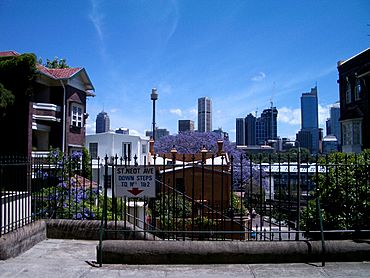
View across Potts Point to the Sydney CBD from St Neot Avenue
|
|||||||||||||||
| Postcode(s) | 2011 | ||||||||||||||
| Area | 0.7 km2 (0.3 sq mi) | ||||||||||||||
| Location | 3 km (2 mi) east of Sydney CBD | ||||||||||||||
| LGA(s) | City of Sydney | ||||||||||||||
| State electorate(s) | Sydney | ||||||||||||||
| Federal Division(s) | Sydney | ||||||||||||||
|
|||||||||||||||
Potts Point is a small and busy suburb in the heart of Sydney, New South Wales, Australia. It's located about 2 kilometers (1.2 miles) east of the main city center, known as the Sydney central business district. Potts Point is part of the City of Sydney local government area.
This suburb sits on a hill, just east of Woolloomooloo. To its west are Elizabeth Bay and Rushcutters Bay. To the north is Darlinghurst. Potts Point is shaped a bit like a trapezoid. At its longest, it's about 1 kilometer (0.6 miles) long and 200 meters (656 feet) wide. Its borders include Macleay Street to the east and William Street to the south.
Contents
Exploring Potts Point's Neighborhoods
Kings Cross is a well-known area. It is not a separate suburb, but it's completely inside Potts Point and Elizabeth Bay. You can find the Kings Cross railway station underground here. The Garden Island facility, which is part of the Royal Australian Navy, is also at the northern end of Potts Point.
A Journey Through Time: Potts Point's History
The land we now call Potts Point originally had the name Derrawunn in the Dharag Language.
Potts Point got its name from Joseph Hyde Potts. He worked for the Bank of New South Wales. Joseph Potts bought a large piece of land by the harbor. This area was then called Woolloomooloo Hill. He decided to rename it Potts Point.
Much of Potts Point and the nearby Elizabeth Bay were once part of a big land grant. This grant was given to Alexander Macleay. He was an important government official in New South Wales from 1826 to 1837. Macleay Street is named after him. Another person who owned land here in the 1800s was Judge John Wylde. Wylde Street is named after him. Potts Point is even mentioned in a poem called "William Street" by the famous Australian poet Henry Lawson.
The 1800s: Grand Homes and Terraces
After Alexander Macleay's time, the land was divided into smaller pieces. Many grand Georgian mansions were built along the highest part of the suburb. Some of these beautiful old homes still stand today. They are now surrounded by newer buildings.
- Rockwall: This two-story sandstone house is on Rockwall Crescent. It was designed by architect John Verge and built between 1831 and 1837. It has a verandah that goes all around the house. Rockwall is the only one of these old homes that still has a garden and is owned by a private family.
- Tusculum: Located on Manning Street, Tusculum is another two-story mansion designed by John Verge. It was built from 1831 to 1835. It was similar to Rockwall House. Later, in the 1870s, verandahs were added to three sides of the house.
- Kenilworth: This house was built around 1869 for Henry Williams. It was on land that was originally part of a grant from 1831.
- Manar: On Macleay Street, Manar is a group of three apartment buildings. They range from an original house built around 1880 to newer buildings from the 1920s.
Other historic buildings in the area include the Mansions Terrace on Bayswater Road. There are also many beautiful Victorian-era terrace houses. These are mostly found along Victoria Street. This street cuts through Potts Point from north to south and is famous for its impressive plane trees.
In 1871, Edmund Blacket built a house called Stramshall on Macleay Street. It was for the Hordern family, who were merchants. This house was later known as Jenner House. It was listed as a heritage site by the National Trust of Australia in 1967.
The 1900s: New Buildings and Changes
Potts Point was one of the first places in Australia to have apartment buildings. From the 1920s until World War II, many new apartment blocks were built here. Because of this, Potts Point has the most Art Deco style buildings in Australia. Some famous examples are the Macleay Regis, Cahors, and Franconia buildings on Macleay Street.
Two important Streamline Moderne style buildings are in Orwell Street: the Minerva (or Metro) Theatre and the Minerva Building. The Metro Theatre was designed by Bruce Dellit and built in 1940. It is a heritage-listed building.
During the Vietnam War, the Darlinghurst Road area, also known as Kings Cross, became a popular place for visitors. Many hotels were built at this time. This helped "The Cross" become a popular tourist spot for many years.
In 1964, Reverend Ted Noffs started the Wayside Chapel. This was a special Methodist church and community center in the Kings Cross area. It began as a small place for people to drop in. It grew into a large center that helps many people in the community.
The 2000s: Modern Potts Point
Around the year 2000, many hotels in Potts Point were bought by developers. They saw that the area was close to transport and other good things. By 2004, most of the tourist hotels were changed into expensive apartment buildings. This led to the area becoming more upscale. Potts Point is still known as one of Sydney's top entertainment areas. It has many pubs, nightclubs, and restaurants.
From 2003 to 2004, the City of Sydney made big improvements to the streets. They widened footpaths, planted trees, and added new paving and lighting.
Historic Places to See
Potts Point has several sites that are listed for their heritage value. This means they are important historical places. Some of these include:
- 2 Macleay Street: Jenner House
- 1–3 Manning Street: Tusculum
- 7 Rockwall Crescent: Rockwall
- 55 Victoria Street: 55 Victoria Street
- 202 Victoria Street: Juanita Nielsen's House
- 18 Ward Avenue: Oakleigh
- 1 Wylde Street: Bomera and Tarana
Who Lives in Potts Point?
At the 2021 census, 7,183 people lived in Potts Point.
In the 2016 census, there were 9,423 people living here. About 38.2% of people were born in Australia. Other common countries of birth included England (5.3%) and New Zealand (3.5%). Most people (54.0%) spoke only English at home. Some other languages spoken were Spanish, Italian, and French. Many people (35.1%) said they had no religion.
Getting Around Potts Point
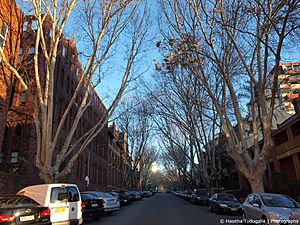
The Kings Cross railway station is an underground station in Potts Point. It is part of the Sydney Trains network. Many buses also serve the area, including routes 200, 311, 324, and 325. There are also night buses.
You can also walk to Potts Point from Woolloomooloo. There are several stairways that connect the two areas. These include Butler and Hills Stairs, and McElhone Stairs. Locals sometimes call McElhone Stairs the "Stairs of Doom" because they have 113 steps!



